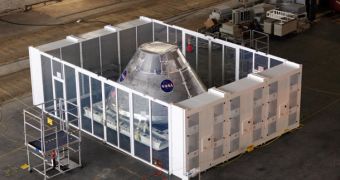The first space-worthy Orion Multi-Purpose Crew Vehicle (MPCV) will soon start to be assembled at the NASA Kennedy Space Center (KSC), in Florida, the former home of the space shuttle fleet. Engineers say that a mobile, roofless clean room could be built around the spacecraft.
For many years, scientists believed that a clean room-like environment could only be achieved by controlling the conditions inside a specially-designed, well-isolated chamber very rigorously. Now, they are beginning to figure out that this may not be the case at all times.
Currently, NASA is testing a design where the clean room is installed around the spacecraft being built. This is a significant departure from regular standards, where the vehicles are assembled inside aseptic conditions, Science Daily reports.
The concept was developed by Austin, Texas-based aerospace company Astrotech Corporation. Engineers here came up with the idea to build an installation that would ensure no dust settles on the spacecraft's surface.
They say that installing two, 10-foot (3-meter) high walls of filter-equipped fans on either side of the capsule could create an even airflow, and enough air motion to prevent any particles from settling on the MPCV's components.
The other two walls of the clean room would be made up of clear materials, and the ceiling would be non-existent. Astrotech experts explain the lack of a roof by the necessity to access the large cranes already installed inside the KSC Vehicle Assembly Building (VAB).
These cranes will be used to hoist the completed Orion atop the Space Launch System (SLS) rocket NASA is developing for its new spacecraft. The delivery system's maiden flight is scheduled for no earlier than 2017.
“The guys over in the Operations and Checkout Building are using this and that's what gave us the idea. It's pretty innovative, so we'll see if it works,” NASA Ground Systems Development and Operations Program engineer, Doug Lenhardt, says.
“The results have been encouraging. We don't have the full story yet, but it's been encouraging,” he concludes.

 14 DAY TRIAL //
14 DAY TRIAL //